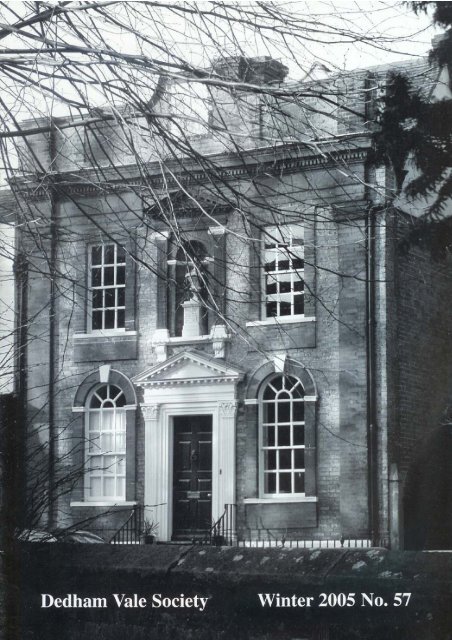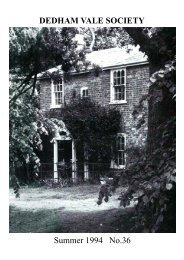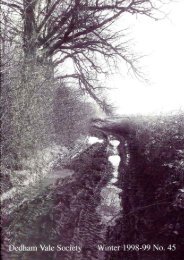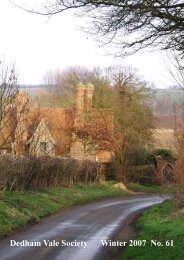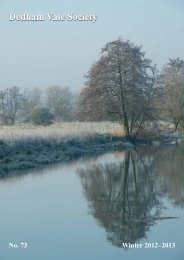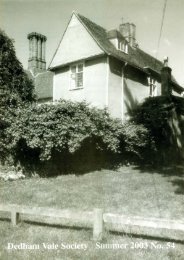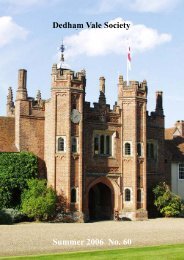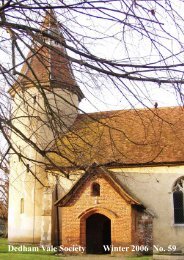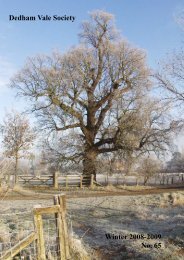Number 57 - Winter 2005 pdf 1.6Mb - Dedham Vale Society
Number 57 - Winter 2005 pdf 1.6Mb - Dedham Vale Society
Number 57 - Winter 2005 pdf 1.6Mb - Dedham Vale Society
- No tags were found...
Create successful ePaper yourself
Turn your PDF publications into a flip-book with our unique Google optimized e-Paper software.
DEDHAM VALE SOCIETYPRESIDENTRobert Erith TD., D.L.CHAIRMANWilfrid TolhurstHONORARY TREASURERMichael ParkerJupes Hill House, <strong>Dedham</strong>Colchester CO7 6BJ01206 322133HONORARY SECRETARYSarah CarrGulson’s Farm, Boxted Church StreetColchester CO4 5SX01206 272207PLANNING OFFICER(Suffolk)David EkingFarthings, Thorington StreetStoke-by-Nayland CO6 4SP01206 337477JOINT PLANNING OFFICERS(Essex)Judith Fowle<strong>Dedham</strong>Dora NicholsLawfordNEWSLETTER EDITORPaul GallifantMill Cottage, Mill HillLawford, Manningtree, CO11 2JZ01206 394202MEMBERSHIP SECRETARYJohn OsbornBailey House, Brook Street,<strong>Dedham</strong>, Essex CO7 6AD01206 3221<strong>57</strong>MEMBERS OF THE COMMITTEEMichael ArcherCharles CloverFrances DodgsonRobert ErithJeremy CohenTel: 01206 322169Tel: 01206 323503Tel: 01206 298346Tel: 01206 227520Tel: 01206 262219Carol Lindsay-SmithAnn MacWilsonChristopher RobinsonQuinlan TerryNella ProbertTel: 01206 263670Tel: 01787 210335Tel: 01787 227179Tel: 01206 337209Tel: 01787 228095Front Cover Sherman’s Hall2
In the 1870s a Commission was set up to look into the running of the <strong>Dedham</strong> schools. Itrecommended that a new elementary school should be built, and that the remit of the GrammarSchool should be expanded to meet the educational requirements of the middle class, as well asoffering an education to poorer children showing academic promise. And so in 1873 the EnglishSchool at Sherman’s closed. However, a tangible reminder of the long years of school use canstill be seen in the many initials carved by Georgian and Victorian schoolboys in the soft redbrickwork of the façade.The elaborate brick frontage that we see today is the result of extensive alterationscarried out in 1730-31. The ‘principal undertaker’ for this work was Mr Nicholas Freeman, whoalso oversaw the rebuilding of the Grammar School in the same year. The total cost of theremodelling of Sherman’s was £533 2s and fourpence half-penny. While this sum includedprovision for internal remodelling, this was relatively modest in character; the chief display wasreserved for the facade, as if wishing to outdo the Grammar School.This front façade is one of the great showpieces of the village and the county. It is anarrow, busy frontage which manages to accommodate all three of the principal classical Ordersas well as a host of other architectural details. The façade is framed by a giant order ofDoric pilasters surmounted by a dentil cornice, all in beautifully cut and jointed soft red brick.There is a fine timber door case with Corinthian pilasters and pediment. Above this there is anarched niche, also pedimented, and framed by Ionic pilasters, all in the same red brick. Theniche now contains an urn, designed by Quinlan Terry and added in 1980. Crowning theelevation is a high parapet, swept up to accommodate a large sundial. There are four large sashwindows, with typical early Georgian thick-section ovolo moulded glazing bars, and red bricksurrounds and aprons.The urn in the niche commemorates the Sherman family and the fact that MarshallSisson, architect, gave the house to the National Trust in 1979. Sisson had moved to the villagein 1934; like Raymond Erith he was (after early experiments with modernism) most at homeworking in the classical idiom. Also like Erith (and Sir Alfred Munnings), he was an originalcommittee member of the <strong>Dedham</strong> <strong>Vale</strong> <strong>Society</strong>, which had been formed in 1937. Mrs Sisson,herself an accomplished artist and musician, was Secretary to the committee.Sisson was known for his sympathetic approach to the repair and adaptation of ancientbuildings such as Thorington Hall and Deanery Tower at Hadleigh. He also oversaw thepost-war restoration of St John’s Smith Square and the reconstruction of the bombed-out WrenCity Church of St Mary Aldermanbury in Fulton, Missouri. This church, having been declaredsurplus to the Diocese of London’s requirements, was dismantled and re-erected on the otherside of the Atlantic at Westminster College, Fulton as a memorial to Sir Winston Churchill, whohad delivered his famous ‘iron curtain’ speech there in 1946. Thus was added a further layer inthe story of Sherman’s and its American connections.Although they moved to Cambridgeshire after the war, the Sissons’ hearts were alwayswith <strong>Dedham</strong>, and they both they now lie buried in the village churchyard. When MarshallSisson died in 1979, he ensured that Sherman’s would be protected for posterity by leaving it tothe National Trust. The house is now let, and is not generally open to the public. However, thereis an Open Day in September, details of which can be obtained from the National Trust.Andrew Derrick, February <strong>2005</strong>5
PLANNING NOTES – SUFFOLK – WINTER 2004/5This brief note is being written on a dank, gloomy afternoon at the end of January <strong>2005</strong>. Itis not easy to enthuse about the success of our efforts to maintain the unspoilt nature of theSuffolk countryside on such a day, even in the <strong>Dedham</strong> <strong>Vale</strong> AONB. However, I believe I amable to report that there have been no major inroads, actual or projected, into the beauty andtranquillity of the Suffolk side of the <strong>Vale</strong> during the last six months – except of course thenumbers of aircraft overhead.There have, inevitably, been several applications to construct highly undesirable newstructures or extensions in the AONB but nothing on a really major scale. The mobile telephonecompanies have continued to leave us alone. A more modest proposal has been submitted toextend Goody’s Farmhouse on the road between Wissington and Bures to which I referred lasttime.It is not all good news, however. There has been no apparent progress on the proposedTraffic Calming Measures for the B1068, apart for some tinkering with the expensive workscarried out in Higham. In December there was a serious accident in Thorington Street to whichspeed almost certainly contributed. Almost all the residents of the hamlet signed a petition to theCounty Council but have at the time of writing received no response.TD and AM Bugg Ltd have submitted an application to expand their “Waste Management”operation at Harpers Hill Farm in Nayland. The <strong>Society</strong> has objected, as it has done many timesbefore, to yet another expansion of this firm’s operation in the AONB. The nature of MessrsBugg’s business is fundamentally inimical to the whole concept and ethos of an AONB and wevery much hope that the County Council, with whom the decision lies on this application, willfinally concede that enough is enough and refuse permission.There is also an application to add five further houses to the modern estate, Strickmere,on the edge of Stratford St Mary. Although this is arguably no more than a small in-fill withinthe village envelope it is not a desirable further intrusion into the open countryside of the AONB.My last point concerns the Public Houses in the Suffolk part of the AONB. In almostevery village and hamlet a pub has closed down in recent years, often for sound economicreasons. Almost all have been converted into a single private dwelling and so far we have beenable to resist attempts to redevelop the premises into a mini housing estate. We have alsomanaged to defeat attempts to build on pub gardens, noticeably in Stratford St Mary. Howeverrecent developments in East Bergholt suggests that it may become increasingly difficult to avoidsuch in-filling in the future. It is certainly an area that needs watching.David Eking, Planning Secretary, SuffolkESSEX PLANNINGIn the Summer 2004 edition of this magazine we reported that we had been involved in anumber of informal talks about the future of planning policies and the changes being caused byrecent Government papers. As a result of these talks a public meeting was held at the AssemblyRooms, <strong>Dedham</strong> on Wednesday 3 rd November 2004 when those present voted in favour of<strong>Dedham</strong> producing a Village Design Statement.6
The Design Statement will take the form of a booklet or brochure using photographs,drawings, diagrams, maps and text to describe the history and geography of the community , thecharacter of the landscape, the character of the settlements, buildings, places, highways andtraffic issues.In the document recommendations will be made about planning issues of importance tothe community and the way the village develops in the future. It is intended that the VillageDesign Statement will become a supplementary planning document to the Local Plan and beadopted as part of that planning policy by Colchester Borough Council. If the document isadopted by the local Council it will ensure that the views of the local community are taken intoaccount by both would-be developers and Council Planners when considering any futuredevelopment in <strong>Dedham</strong>, whether large or small.Consultation with the community is at the heart of the document’s preparation. It willstart with a workshop focused on village characteristics on Saturday 14 th May <strong>2005</strong>. If you are amember of the <strong>Society</strong> living in the Parish of <strong>Dedham</strong> please put the date in your diary. It isintended that it will be an enjoyable event for everyone living in the village, whatever their age orinterests. Details will be published in the Parish Magazine and on postersSeveral planning applications linger over from the summer. The Harwich Port inquiryfinished in the autumn and now we must wait for the findings.The application for an Elderly Mentally and Infirm Home at Blackbrook Hill, Gun Hill,<strong>Dedham</strong>, which was refused by the Council last year on the grounds that it was an unjustifieddevelopment in the countryside and particularly in the <strong>Dedham</strong> <strong>Vale</strong> AONB, is to go to appeal.<strong>Dedham</strong> Hall’s application for the conversion of some old farm buildings into holidaylets, with vehicular access along the footpath to Flatford Mill, was granted in the New Year.Very strong representations were made to the Borough Council regarding the use of this popularfootpath by holiday let vehicles, there being an alternative route already in existence.The ram raiding of the Co-op Stores in <strong>Dedham</strong> High Street in June and then again inSeptember has given rise to the need for some form of protection for the store’s listed shop front.Plain dark green bollards have been proposed by the Co-op, three on either side of the doors, andare generally thought to be the best solution to a sensitive problem. However the ConservationDepartment does not agree and so we await the outcome of an imminent Planning Committeedecision.Sometimes it seems that planning regulations and laws change monthly, if not weekly, anddevelopers are making good use of all the little loopholes that arise at such times! This is mostnoticeable around the edges of the AONB. The <strong>Society</strong> objected extremely strongly to a recentapplication to re-designate an area in Tendring District Council’s new local plan to residential(over 1,000 houses) and mixed-use development totalling 38 hectares. The site is in Lawford andwould effectively join Lawford and Mistley. We have also heard of other similar applications inthe area.The <strong>Dedham</strong> <strong>Vale</strong> AONB is a very precious area, continuously under threat, and the needfor members to take note of, and respond to, planning applications in their area is an increasingone. Often you will hear about planned changes of use and developments in your village longbefore formal application is made to the Council. Please let us know, don’t assume we have beeninformed. It is normal practice for developers, both large and small, to have quite detaileddiscussions with planners long before their application is registered.Dora Nichols, Judith A Fowle7
house and restaurant. Another is that the present building could be converted to a singlehousing unit, as has happened in other parts of the village, and elsewhere. A more populardecision with the former patrons, of course, would be for it to be sold and reopened as apublic house and restaurant but is this a realistic possibility? The village pub, it seems, is nolonger as popular as it once was. Drinking habits are changing and to survive today in most,but by no means all, cases they have to offer tempting restaurant facilities sufficient toattract diners from beyond the village. Up to the last few years the Anchor had made greatefforts to establish itself as a middle range restaurant with separate bars for non-diners butthis ended with changes in management and policy.Offering food as well as drink is certainly not new. Two and a half centuries agovillage inns would supply food and overnight accommodation for travellers and would oftenprovide popular pastimes such as cock fighting. Indeed the building still stands on GunHill, <strong>Dedham</strong> that was once an 18 th Century venue for the blood sport. The Gun, which isnow a private residence, still operated as a public house up to 1961 although by then cockfighting had long ceased. In 1754 however this was not the case, as was noted by GlynMorgan in his 1963 book about Essex. It also had the distinction, he states, of being the first(or last) pub in the county and a popular overnight alternative to the Colchester inns.Now a private residence The Gun was once a local centre for cock fightingDuring the early decades of the twentieth century there is evidence of as many astwelve inns within the four square miles of the <strong>Dedham</strong> parish boundary. In many casesthe buildings still stand and although there is unlikely to be anybody now alive who canremember the ‘Live and Let Live’ inn on Ardleigh Road – it is listed as having closed in1920 – the building, as with the Gun, still stands as a private residence although now knownas ‘The Old Ale House’. It was in the well of the garden of the cobblers shop two doorsaway that the murdered body of Police Sgt John Harvey was discovered in 1894.9
Records show that ‘The Compasses’ in <strong>Dedham</strong> High Street, the site of the presentCompasses Book Shop, was an alehouse between 1769 and 1911. Other inns that have beenlicensed over the years are the ‘Beehive’ in 1911, The White Hart as far back as 1769, The‘Crown’ 1769-1859 and far more recently ‘The Lamb’ which was licensed in 1788 and wasonly converted to a private residence in the last decade. Many residents will remember thebuilding that was once the Prince of Wales Ale House at the corner of Coopers Lane almostopposite Castle House. Records show it was licensed between 1911 and 1920 although it mayhave continued as an ale house up to the pre-war period. The building was demolished tomake way for the five houses that now stand on the site.The Old Ale House a private residence which was once the ‘Live and Let Live’. The inn featuredin the unsolved murder of a local policeman in 1894.At the beginning of <strong>2005</strong> there remain just three establishments in <strong>Dedham</strong> thatwould normally classify as Inns or Public Houses although the definition of a place thatserves food and/or drink could be extended to Milsoms and The Boathouse, both of whichhave been successfully opened during the past few years. Perhaps the very popularity andsuccess of these two restaurants gives a pointer to what needs to be accomplished if thevillage pub is to remain viable. The remaining three include the Rose and Crown (just Crownto the patrons!), which was closed in June of 2004 and perhaps surprisingly re-opened undernew management at the end of that year. Unlike the Anchor or the two village centre publichouses, the Sun and the Marlborough, this building is far less old and dates back only to the1920s. An earlier inn bearing the same name was knocked down, much to the disgust ofAlfred Munnings who described in his 1952 autobiography: “My one joy, thirty years ago,was in knowing that my home was near a perfect river and village in an unspoilt country. Theroad curved from the village to Castle House in slow and gradual ascent between clippedfences grown with oaks. On the left stood an old thatched inn like a George Morland picture,but it has been long superseded by a building which is an insult to its predecessor. Allhas altered.” Hardly surprising perhaps that the artist resented the intrusion of what hedescribed as “Tudorish fabrications” on land mid way between his own Castle House and thevillage centre.10
Referred to by Sir Alfred Munnings in his autobiography the recently reopened Rose and CrownPublic House, <strong>Dedham</strong>Now a private residence but until a few years ago the Lamb Public House11
In the case of the 15 th Century timber framed coaching inn, The Sun, which itself wasclosed for major refurbishment work in early 2003 and reopened in July of that year, thereare signs that the gamble is beginning to pay off. A strong emphasis on Mediterranean foodand a large selection of accompanying mid-ranged wine and locally brewed beers is findingfavour with customers. High business rates and the cost of maintaining good quality staff,however, means that the chances of long-term success depend very much upon regularturn-over mid-week as well as at more popular times. Accomplishing this is the realbreakthrough that will perhaps determine the survival of the fittest. Certainly the Sun, and itsclose neighbour the Marlborough, both of which seem to epitomise the stereo-typical Englishvillage pub, should be given the support and encouragement that could make that possible.But does a village pub have to be first and foremost a restaurant in order to survive?Well the answer is a guarded ‘no’ if the example of one establishment located very close tothe most northerly part of the <strong>Dedham</strong> <strong>Vale</strong> is anything to go by. The White Horse is the onlypub in the small village of Edwardstone and is not even located on the main through road andyet it flourishes. There are a number of reasons why this is so not least being the consistentlyhigh quality of management. The landlord is popular, understands his business and iscommitted. Of course it helps that the pub is not rented and as a “free house” the licensee hasimmensely more buying power as the brewers compete against each other to sell to him.Factors that have caused other pubs to decline seem not to apply in this case. Traditional pubpastimes such as dominoes, darts and cribbage are available to local people and they arepopular. There is an additional factor and that is that by being the only pub in the village thelocal authority, in this case Babergh, waive the normal business rates. This alone is often thedifference between success and failure between survival and closure. Whilst this enlightenedpolicy is to be applauded it is not going to help the three remaining <strong>Dedham</strong> pubs unless thatvery unwelcome prospect became a reality and two of the three go the way of all those earlierestablishments in <strong>Dedham</strong>. A few might say that prospect is inevitable although surely themajority still incline towards a less gloomy scenario?Aircraft over the <strong>Vale</strong>Over-flying of the <strong>Vale</strong> was supposed to have largely ceased by March 2004.Members will know only too well that this is not the case and, indeed, the flight-paths havespread more widely so that many more villages are affected.It had been understood that the CAA/NATS would move the flight-paths furthernorth thus allowing the <strong>Vale</strong> to return to its AONB stated aim of being ‘tranquil’. The<strong>Society</strong>’s committee were in favour of a move to the south where the A12, A120 and railwaywould ‘absorb’ the noise from the sky but the authorities decided otherwise and, as a result,the communities in south Suffolk have been affected for the first time.Rumours have circulated that the <strong>Dedham</strong> <strong>Vale</strong> <strong>Society</strong> is responsible for causing theincreasingly noisy situation and, indeed, an item of news in the February <strong>2005</strong> edition of the‘Box River News’, based in Boxford, appears thus:12
DEDHAM VALE SEEK TO INCREASE FLIGHTS OVER SOUTH SUFFOLK Readersmay have heard on BBC Radio Suffolk that a Mr T Hill of Bentley has been awardeda judicial review of the NATS decision to transfer flights from the <strong>Dedham</strong> <strong>Vale</strong> from March2004 to fly over South Suffolk instead. It seems that only about fifty percent of the flights weremoved from <strong>Dedham</strong> <strong>Vale</strong> after March and the <strong>Dedham</strong> <strong>Vale</strong> <strong>Society</strong> have now joined forceswith Mr Hill and are seeking an agreement with NATS for all flights over the <strong>Dedham</strong> <strong>Vale</strong> tobe diverted, presumably over South Suffolk. A nice friendly and neighbourly gesture on theirpart. The result of the review is expected early February (Ed) An understandable butmistaken view.Because over-flying of the <strong>Vale</strong> has continued seemingly unabated, the Committee has decidedto act as a Co-Claimant with Mr Tom Hill in order to seek a Judicial Review concerning thefailure of CAA/NATS on two counts: (1) failure to move the majority of aircraft flying to andfrom Stansted and Luton away from the <strong>Vale</strong> and (2) failure to carry-out an environmentalimpact assessment following the supposed substantial reduction from March 2004 of aircraftover-flying the <strong>Vale</strong>. Thus it has been decided by the Committee that funds will be required tosupport the challenge and the letter accompanying this Newsletter details the reasons.SSATAG South Suffolk Air Traffic Action Group.Because the flight-paths have spread north, the population in the South Suffolk area hasrightly been concerned at the increase in noise from aircraft in the last twelve months. Despitethe fact that residents in the <strong>Vale</strong> have seen little change in their situation, those in SouthSuffolk have become only too aware of the noise in the sky. SSATAG has created six specificworking-groups in order to more efficiently decide on strategies that will be effective in theirfight against the flight-paths. They report that on August 16 th 2004 116 aircraft flew overBoxford at about 7,000 feet and that it has been like this or worse since March 18 th 2004.Before that date the area had experienced none of that traffic. The forecast is that it willdouble within the next ten years. SSATAG is looking for members and more particularly,those willing to help with their campaign. E-mail: info@ssatag.org or website: www.ssatag.org The mailing address is SSATAG Newsletter, PO Box 82, Milden, Ipswich IP7 7WX.STOP STANSTED CAMPAIGNMost readers will know that the High Court ruled recently that the Government actedunlawfully in specifying the most environmentally damaging option for Stansted’s proposedsecond runway. In a letter to supporters dated February 23 rd , Peter Sanders, Chairman, writesthat the judgement has delivered a major setback to BAA and the Government’s plans. TheWhite Paper has not been overturned but if BAA submits a planning proposal for a secondrunway, a public enquiry will be held and the planning authorities will have to be satisfied thatall options have been considered, which, up till now, no proper assessment has been made onthe basis of environmental impact or commercial feasibility.Mr Sanders points out that BAA’s main airline customers are unwilling to bear thevery substantial development costs and that British Airways, BMI, Virgin and otherHeathrow-based airlines are not prepared to pay for a new Stansted runway for the benefit ofRyanair and Easyjet. The Stop Stansted campaign will “continue to oppose the plans at everyturn”, in order, “to prevent the unwarranted sacrifice of homes, heritage and the environment”.E-mail: info@stopstanstedexpansion.com website: www.stopstanstedexpansion.com StopStansted Expansion is a working group of NWEEHPA. The mailing address is: PO Box 311,Takeley, Bishop’s Stortford, Herts CM22 6PY Telephone: 01279 870558.13
The <strong>Dedham</strong> <strong>Vale</strong> <strong>Society</strong> – Why be a Member?Carol Lindsay Smith is a new member of the committee and has raised some thought-provokingissues that are very relevant to the aims and aspiration of the <strong>Society</strong>.QUESTIONS AND IDEAS…… As a new member of the DVS Committee I want to be clearabout how best to support the <strong>Society</strong>. So the following questions and ideas are raised with thehope that, with better understanding, I can play a part in recruiting new members, getting existingmembers more involved and generally raising the profile of the DVS.UNDERSTANDING THE SCOPE OF THE DVSMain Concerns Is there a priority list (written or unwritten) of key issues which the DVS is workingFOR or AGAINST? Is this an ad hoc list of current threats? (eg over-flying planes and Stansteddevelopments) or an overarching and continuous concern to protect the AONB into which problems areslotted as they arise? If there is a priority list, is it reviewed from time to time? Is the generalmembership involved in setting priorities - and how do they know what the DVS is currently focussed on?A.O.N.B. Is there a DVS stance on whether or not the AONB should be extended and if so howfar? Would greater size mean greater protection? How is this issue dealt with?Relationship with other conservation societies and action groups. Is DVS finely focussed on itsown issues and territory, or is there commitment to joining forces with other groups with parallel oroverlapping concerns? (eg SSATAG, SPS, Transport 2000, River Stour Trust ….)Relationship with Parish Councils and planning control teams. Concern is sometimes expressed aboutthe capacity of parish councils and planning departments to make good decisions on sensitive planningmatters. Is there a strategy to build relationships with the hope of influencing policies and decisions ingeneral? Or is contact mainly through opposing contentious planning proposals as they come up?Making a positive response to good developments. It seems that much DVA effort is againstchange. Is there a counterbalancing effort to seek out and recognise sensitive or beneficial changes,both residential or public, built or environmental?WHY BE A MEMBER?Members need to know what they are joining up to, what they can expect in return for theirsubscription and what is expected of them.New Members. Other than the application form what information is given about the DVS? How dopotential members find out about the extent and limitations of DVS’ role? Do most people joinwhen they face a problem on their doorstep? How could members be attracted in a less negative way?CONSTITUTION. HOW ARE MEMBERS INFORMED ABOUT THE CONSTITUTION, HOWOFFICE HOLDERS AND COMMITTEE MEMBERS ARE APPOINTED, THEIR DUTIES ANDDURATION OF APPOINTMENT? WHAT IS THE PROCESS FOR MEMBERS WITH TIME/SKILLS/COMMITMENT TO BECOME ACTIVELY INVOLVED? HOW DO MEMBERS KNOW WHATACTUALLY NEEDS TO BE DONE?Support to members. How easy is it for members to ask the DVS for help in challenging a planningapplication or changes affecting their area? Who can they approach? Is there, or does there need to be, acommittee member with some sort of pastoral care for members? As well as helping with individualproblems this could provide a useful conduit of info into the DVS about the real concerns of members.What do members want? How are members sounded out about their hopes and fears for the AONB?Are they as worried as committee members about a building extension which breaks the skyline – or arethey more worried about the impact on the AONB of vehicle size and speed through the lanes, closingpubs and post offices? What do they hope the DVS will fight for on their behalf?14
Information for members. It is predictable that some of the worst building blunders could bereduced if members (and the community at large) knew where to get architectural and constructionservices from firms which are sensitive to working on buildings in the AONB. Providing lists ofappropriately experienced professionals, builders and suppliers need not draw the DVS into a legalminefield provided it is made clear that no individual or firm is endorsed by the DVS.Register of members relevant skills and experience ? When individuals take the first step to jointhe DVS they are signalling concern and commitment to the AONB. How can we encourageinvolvement of what must be a huge untapped pool of professional and practical skills, contactsand perhaps even spare time amongst the existing 700 members and even more potential members.RAISING THE PROFILE OF THE DVSAnnual General Meeting. As the main conduit for informing and sounding out the generalmembership, and possibly for attracting new members could it be advertised more widely, egthrough village newsletters, notice boards, reminders on outside of newsletter envelope. etc. Couldthe AGM be held in a different parish each time, to bring it closer to different groups of members?Newsletter. Are copies sent to chairs of parish councils, planning control offices, other conservationsocieties and pressure groups, libraries etc?Advertising in the DVS newsletter?? Advertising by local shops, providers, builders etc. couldprovide modest income as well as encouraging support of local enterprises.Press Officer. The need to use the media to promote the DVS perspective was discussed at a recentmeeting but who should do it was not resolved. For the past three months a DVS supporter haskept watch on local and national press revealing frequent (missed) opportunities for both proactiveand reactive comments from the DVS.Promoting competitions. Could the DVS give annual awards to highlight excellence in development –adaptation or improvement to existing building, new buildings, improvement to environment,opening up of a view or removal of an eyesore?Sponsoring projects. Could an agreed percentage of membership fees be spent each year on sponsoringa project to benefit the whole community – a new footpath, village signs, seats at a viewing point,wild flower meadow, reclaiming a pond?Open House weekend Could DVS promote a local version of the London scheme whereby interestingprivately owned properties or usually closed areas of significant public buildings are open to the public?Walks on privately owned land. Could DVS persuade local landowners to to allow annual guidedwalks through usually hidden landscape?Lectures by related organisations. Transport 2000 could, for example, encourage debate aboutspeed limits and de-cluttering of village roads; conservation officers could speak about their rolein the planning process – and specifically how to get help before making a doomed application.Ignorance blight. Many of us have made terrible mistakes in the past – so does the DVS have arole to make it easy for property owners or builders to find architects, designers, builders andsuppliers of materials who are sensitised to working in the AONB?These and other ideas will be discussed in due course by the Committee. Comments and any othersuggestions from members will be very welcome. As far as the AONB is concerned the DVS haspressed hard for a westward extension to encompass the area around Bures and Lamarsh but theCountryside Commission have said that, at present, it is too expensive to carry out! (Ed.)15
Architectural Awards.Following on from one of the suggestions in the previous article, it is very pleasing toreport that the architectural practice of Geary and Black, based in <strong>Dedham</strong>, won two awardslast autumn for their work on the house described in last winter’s edition in the article entitled,“Living in a listing Building”.The categories were as follows:-RIBA East Spirit of IngenuityArchitectural Awards.Heritage Award – ConservationHome Award - New Build,Extensions and ConversionsWood Farm an award-winning 16 thCentury Suffolk farmhouseGUIDED WALKS PROGRAMME <strong>2005</strong>THE HISTORIC STOUR – WALKS CELEBRATING MAGNIFICENTBUILDINGS IN ENGLAND’S FINEST LOWLAND LANDSCAPE.Assington - Mills and Hills: Conservation in the 21 st Century Sunday 17 AprilA walk looking at the range of initiatives to enhance the landscape and built heritage of theAssington Brook Valley. 10.30am to 4.30pm. 6 miles - Moderate Plus. Long walk - Bring apicnic lunch or book a hot lunch (£7 per head) at Mill Farm.A Castle in the Sky!Sunday 22 MayWith the help of an experienced archaeologist discover how people have been influencing thelandscape of Mount Bures since pre-history. Includes a visit to the mysterious “Mount”.10am to 1pm. 5 miles - Moderate Plus.Summers PastSunday 19 JuneOur very own Archaeological Encounter around Brundon, Borley and the riverside. Led by aSuffolk County Council Archaeologist. Discover the clues that enable us to find out who usedto live in the area and what they did. 10am to 1pm. 3 miles - Easy/Moderate – Bring a picnic.Bus & Train (Sudbury).Types of Walk - All our walks are taken at the pace of the slowest walker. We aim tomake them enjoyable as well as informative. Walks begin at stated time so please arrivein good time. Jasmin Hicks, <strong>Dedham</strong> <strong>Vale</strong> & Stour Valley Countryside Project, Tel;01473 58318416


